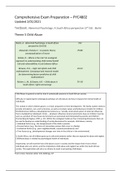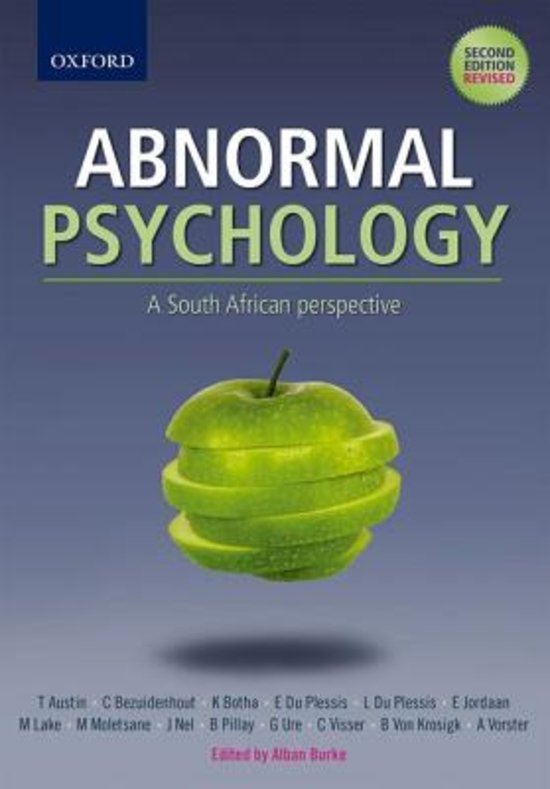Comprehensive Exam Preparation – PYC4802
Updated 2/01/2021
Textbook: Abnormal Psychology: A South Africa perspective (3rd Ed) - Burke
Theme 5 Child Abuse
Burke, A - Abnormal Psychology: A South Africa 372
perspective (3rd Ed)
Alexander, Pamela C – A systems theory 79-88
conceptualization of incest
Atilola, O – Where is the risk? An ecological
approach to understanding child mental health
risk and vulnerabilities in sub-Saharan Africa
Browne, D.H. – High risk infants and child 43-53
maltreatment: Conceptual and research model
for determining factors predictive of child
maltreatment
Richter, L. M., & Dawes, A.R. – Child abuse in 79 -93
South Africa: rights and wrongs
Child Abuse in general as well as how it contextually presents in South African society.
Difficulty in explaining the aetiological pathways of child abuse and how it impacts the mental health of
individuals.
The context in which children grow is a critical component in their development. The family system needs to
provide stimulation, care, and nurturance, as well as inculcate values and behavioural models for children.
Bronfenbrenner defines a developmental context as a “socially constructed system of external influences
that is mediated by individuals’ minds ... whatever influences local environments have on children must be
seen as a product of how these environments are perceived and interpreted by parents and children”
(Furstenberg & Hughes, 1997, p. 27). Within the ecological model are four interacting dimensions that can
be used to develop an understanding of social phenomena for example, child abuse, namely:
• Individual factors (e.g., the temperament of the child or parent).
• Process factors (e.g., the forms of interaction process that occur in a family).
• Contextual factors (e.g., poor neighbourhoods, corporal punishment); and
• Time factors (e.g., developmental changes over time in the child or in the environment)
In South Africa, not all children grow up in safe environments rather they are exposed to abuse and neglect.
Childhood abuse is related to psychological health of individuals.
Importantly, we will examine how child abuse occurs in society and the impact that it has to those
individuals who are victims, and the implications child abuse and neglect has within the South African
society. This exploration will aid us as citizens to assist in preventing child abuse.
From Unisa Tutorial Letter 101 2020 pg. 67
, Define the various types of child abuse:
Physical Abuse
❖ Intentional acts of commission by a caregiver that cause actual physical harm/ have the
potential for harm to a child
o hitting
o kicking
o beating
o shaking
o strangling
o suffocating
o burning
Emotional Abuse
❖ Failure of a caregiver to provide an appropriate and supportive environment.DSM-5
(Psychological abuse)- non-accidental verbal or symbolic acts by a child’s parent or caregiver
that result I, or have reasonable potential to result, in significant psychological harm to the
child
o Includes acts that have an adverse effect on the emotional health and development
of a child
o Restricting a child’s movement, denigration, ridicule threats and intimidation,
discrimination, rejection, and other non-physical forms of hostile treatment
Sexual Abuse
❖ Non-consensual sex/ an adult or older adolescent uses a child for sexual stimulation incest
o Engaging in sexual activities with a child (asking/ pressuring/ other means)
o Indecent exposure
o Child grooming
o Child pornography
o Child marriage
Cyber-sexual Abuse
❖ Known as Cyber molestation due to its virtual, distanced and the use of the internet or cell
phones. predators utilizing modern forms of technology to coerce targeted victim into
inappropriate and sometimes illegal sex acts.
o Cyber bullying
o Grooming
o Sexual abuse
Distinguish between Child Abuse and Neglect
❖ Neglect
o Failure of a parent to provide for the development of the child- where the parent is
in a position to do so- in one or more of the following areas
▪ Health
▪ Education
▪ Emotional development
▪ Nutrition
▪ Shelter
▪ Safe living conditions





